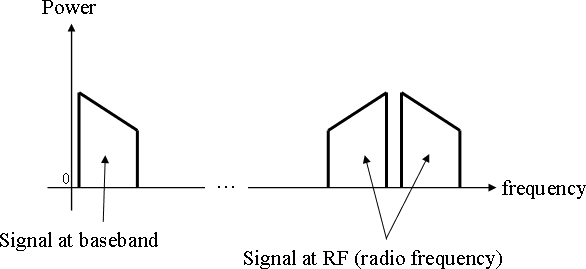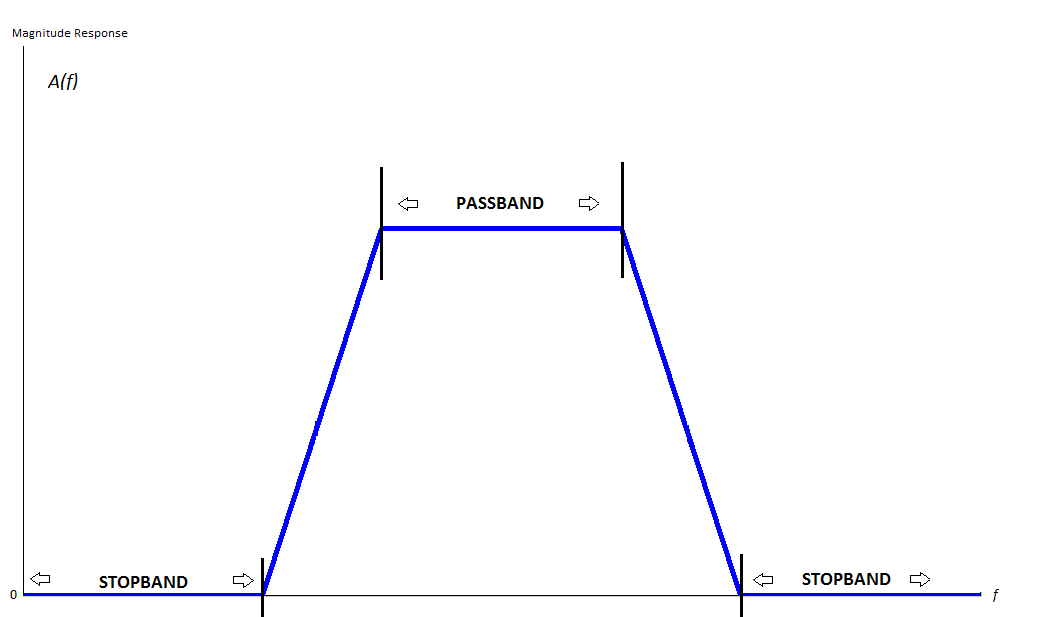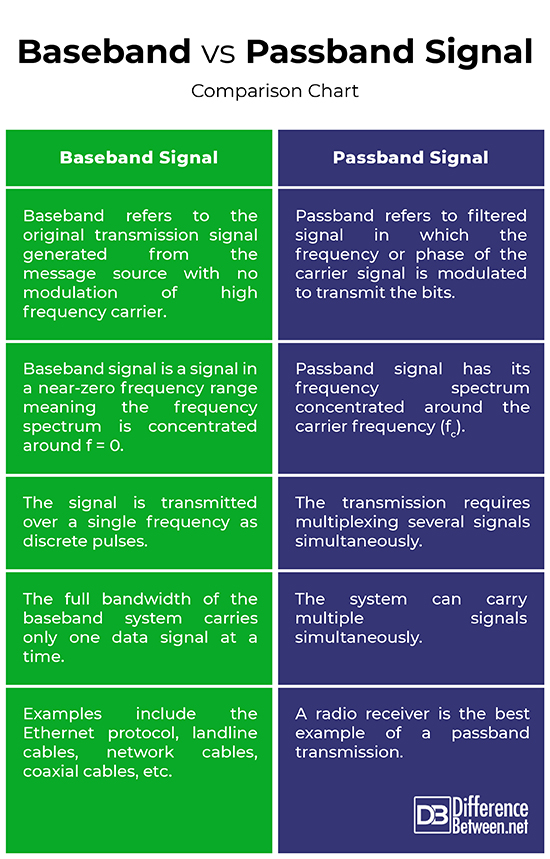Difference Between Baseband and Passband
We come across many forms of communication in our daily life. But for a successful communication to occur, three key components must be present: sender, receiver and the communication channel. These are the three most important key components that are present in any communication system. But there is more to the whole communication system than just sending and receiving. There’s modulation and demodulation, and then we have two most common forms of digital transmission – baseband transmission and passband transmission. We take a look into the two digital transmission channels and highlight some key differences between the two.

What is Baseband Signal?
Baseband signal, also known as lowpass signal, is a signal in a near-zero frequency range generated from the information source. It is related to digital signal transmission in which the whole bandwidth carries only one data signal at a time. In other words, every signal requires an exclusive piece of the shared media. For example, if I am using the media, no one else would be able to use it and they have to wait for their turn to use the media. Baseband, as the name suggests, refers to the original transmission signal with no modulation of high frequency carrier. In other words, the transmission signal has been demodulated to its original frequency. Simply put, baseband refers to the transmission signal before modulation with frequency much lower than the signal post modulation. Baseband signal is normally a message signal and only one communication channel is available at any time.

What is Passband Signal?
Passband signal refers to filtered signal or modulated signal in which the frequency or phase of the carrier signal is modulated to transmit the bits. It is based on the concept of digital data transmission post modulation of high frequency sinusoidal carrier. It changes some property of the carrier wave such as frequency or amplitude with respect to the data signal wave meaning the signal is transmitted at high carrier frequency with modulation. In simple words, if a modulated signal is transmitted over the channel, it is called Passband transmission. The passband signal has its frequency spectrum concentrated around the carrier frequency. They are ideal for communication channels with frequency response equivalent to a band-pass response effect, similar to wireless transmissions. Passband signals are normally used at high frequencies and for longer distance transmissions.
Difference between Baseband and Passband
Meaning
– Baseband is one of the simplest forms of digital communication which uses discrete pulses in a near-zero frequency range without modulation. Baseband signal, as the name suggests, refers to the original transmission signal generated from the message source with no modulation of high frequency carrier whatsoever. Passband signal, on the other hand, is yet another form of digital transmission that uses modulation meaning the frequency or phase of the carrier signal is modulated to transmit the bits. It is based on the concept of digital data transmission post modulation of high frequency sinusoidal carrier.
Frequency
– Baseband signal is a signal in a near-zero frequency range meaning the frequency spectrum is concentrated around f = 0, hence it is also called a lowpass signal as it can include frequencies close to zero. There is no modulation of high frequency carrier in baseband digital transmission. Passband signal, on the other hand, has its frequency spectrum concentrated around the carrier frequency (fc). So, passband signals are normally used at higher frequencies and for long distance transmission. Baseband is the transmission signal before modulation with frequency much lower than the signal post modulation.
Transmission
– In baseband transmission, the signal is transmitted over a single frequency as discrete pulses meaning the full bandwidth of the baseband system carries only one data signal at a time. And the signal is discrete both in amplitude and time. Passband signal refers to signals post or including modulation with frequencies concentrated around carrier frequency, hence it is called transmitted signal or modulated signal. It is the transmission after shifting the frequency of baseband transmission to higher frequency spectrum using modulation. The transmission requires multiplexing several signals simultaneously.
Example
– Baseband signal is normally a message signal and is ideal for communication channels whose frequency response has a lowpass filtering effect. For example, twisted pair telephone lines, computer network cables, coaxial cables, etc. The best example of baseband transmission is the Ethernet protocol, but they are limited to single transmission channels. Passband signal, on the other hand, is ideal for communication channels whose frequency response has a bandpass response effect, for example, a radio receiver has a bandpass filter, and other wireless communication channels.
Baseband vs. Passband Signal: Comparison Chart

Summary
Baseband transmission is one of the simplest forms of digital signaling that uses discrete electrical pulses without modulation and the signal stays close to the zero frequency spectrum as opposed to passband transmission, which has its frequency spectrum concentrated around the carrier frequency. Baseband signal is normally a message signal and is ideal for communication channels whose frequency response has a lowpass filtering effect, whereas passband signal is best for communication channels whose frequency response has a bandpass response effect. Baseband signal is normally referred to as the original message signal which is intended to be transmitted whereas passband signal refers to modulated or filtered signal which ultimately gets converted back to baseband signal.
- Difference Between Caucus and Primary - June 18, 2024
- Difference Between PPO and POS - May 30, 2024
- Difference Between RFID and NFC - May 28, 2024
Search DifferenceBetween.net :
1 Comment
Leave a Response
References :
[0]Corazza, Giovanni E. Digital Satellite Communications. Berlin, Germany: Springer, 2007. Print
[1]Guimaraes, Dayan Adionel. Digital Transmission: A Simulation-Aided Introduction with VisSim/Comm. Berlin, Germany: Springer, 2010. Print
[2]Lee, Edward A. and David G. Messerschmitt. Digital Communication. Berlin, Germany: Springer, 2012. Print
[3]Image credit: https://commons.wikimedia.org/wiki/File:Baseband_to_RF.png
[4]Image credit: https://commons.wikimedia.org/wiki/File:Filter_Example.png

Wow! In the end I got a web site from where I be able to in fact get useful data concerning my study and knowledge.